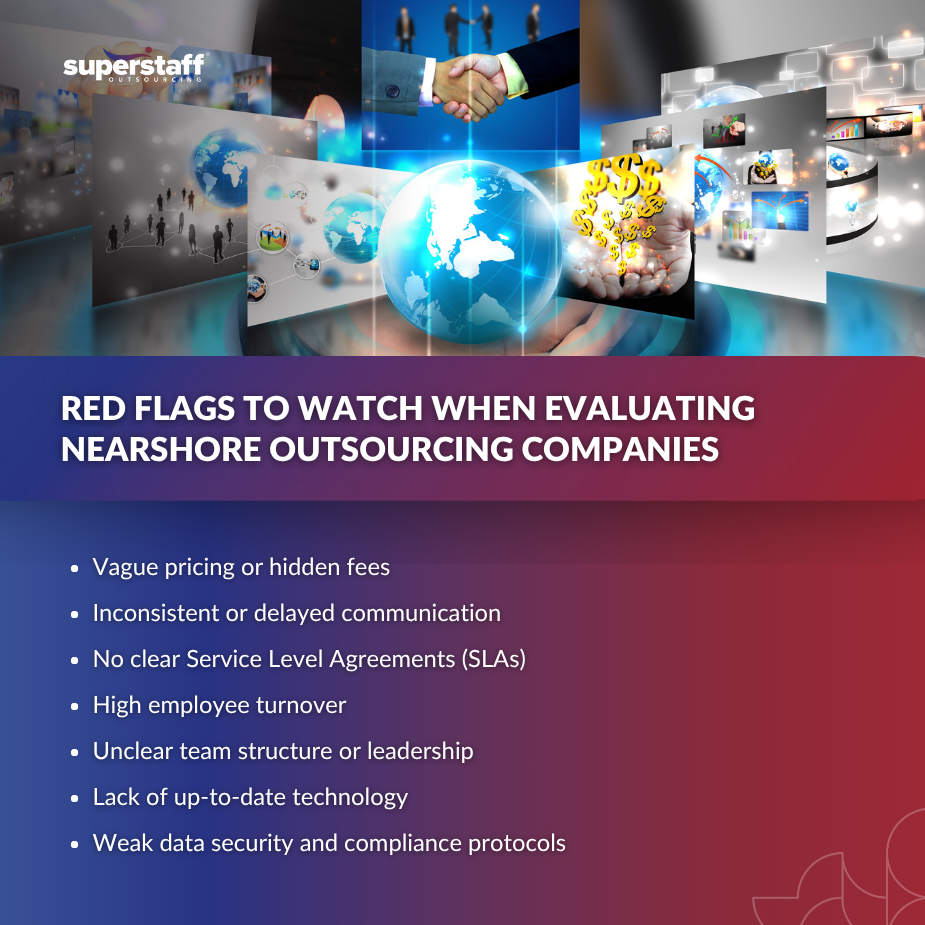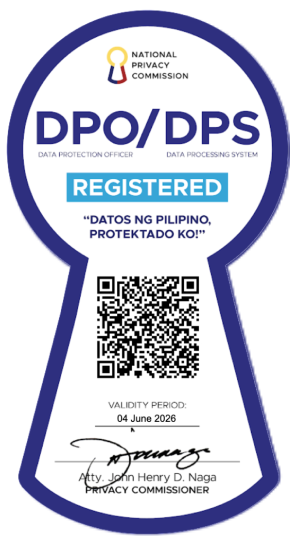
Choosing a nearshore partner can fast-track growth, but only if you pick the right one.
Nearshore outsourcing companies have become a go-to solution for businesses looking to balance quality, speed, and cost. With closer time zone alignment, stronger cultural compatibility, and the ability to communicate in real time, nearshoring offers advantages that offshore and onshore models can’t always deliver. But while the model is promising, the outcomes depend heavily on the partner you choose.
Not all nearshore outsourcing companies are built the same. Some bring proven expertise and infrastructure, while others may fall short on transparency, talent retention, or compliance. A poor outsourcing decision can lead to operational disruptions, data vulnerabilities, and customer dissatisfaction—negating all the benefits nearshoring is supposed to bring.
In this blog, we’ll break down the red flags to watch out for when evaluating potential nearshore outsourcing partners. Our goal: to help you make confident, informed decisions that set your business up for long-term success, not setbacks.
1. Lack of Transparency in Communication and Pricing
One of the first warning signs is a nearshore vendor that isn’t upfront about operations or cost structure.
Vague pricing models or hidden fees can quickly erode trust and derail budgeting. Similarly, delayed responses or inconsistent communication during the vetting process may indicate how they’ll handle your account once a contract is signed.
Clear Service Level Agreements (SLAs) and well-defined scopes of work are must-haves. If a company dodges questions about key performance indicators or avoids discussing their operational structure, consider it a major red flag.
Transparency issues often reflect deeper operational problems, including poor staffing.
2. High Turnover or Unclear Team Structure
A revolving door of employees or unclear leadership structure can destabilize your operations.
If you notice frequent changes in account managers or struggle to get introductions to team members, take note. Consistency matters—especially in customer service or tech support roles where deep familiarity with your brand and systems is critical.
Ask about retention rates, training programs, and how teams are managed internally. A provider with high turnover may struggle to maintain service quality, causing you to spend more time retraining than scaling.
Beyond the team, take a closer look at the provider’s infrastructure.
3. Outdated Technology or Weak Security Measures
Nearshore outsourcing companies that cut corners on tech and security expose your business to serious risks.
If a provider doesn’t mention encryption, data compliance, or redundancy protocols, that’s a major concern. Security certifications like HIPAA, SOC 2, or GDPR aren’t optional—they’re expected in modern outsourcing partnerships.
Ask detailed questions about the platforms they use for collaboration, CRM, workflow, and cybersecurity. Avoid vendors that are unwilling to undergo audits or demonstrate proof of compliance.
While tech and compliance are essential, cultural compatibility is just as critical for day-to-day operations.

4. Poor Cultural or Language Fit
Even in nearshore settings, gaps in culture and communication can erode team effectiveness.
If conversations feel overly scripted, or if you notice inconsistent English or weak understanding of your brand’s tone, consider it a red flag. Many nearshore outsourcing services promote multilingual capabilities, but that doesn’t always translate to fluency or business-level comprehension.
Cultural compatibility is particularly important for client-facing roles, where nuances in tone, empathy, and etiquette directly affect customer experience. Misalignment here can lead to miscommunication and reputational risk.
Beyond soft skills, assess how well the partner handles business continuity.
5. No Clear Business Continuity or Disaster Recovery Plan
A good outsourcing partner prepares for the unexpected—those that don’t could leave you stranded.
Ask whether the provider has a documented disaster recovery plan. Can they shift to remote work if needed? How do they respond to natural disasters, political instability, or infrastructure failure?
A mature provider should be able to share past examples of how they maintained operations through disruptions. Business continuity planning shows they take your partnership seriously—and are ready to protect it.
Let’s also look at warning signs in how the company talks about results.
6. Overpromising Results Without Data to Back Them Up
If something sounds too good to be true, it usually is.
Be cautious of nearshore outsourcing companies that guarantee “zero errors” or instant success without explaining how they plan to deliver. Reliable partners back up their promises with case studies, performance metrics, and client testimonials.
Ask how success is measured, how frequently reports are delivered, and whether KPIs are customizable. If they can’t show real-world examples or hesitate when asked for references, proceed with caution.
Lastly, be cautious if the provider lacks legal or ethical alignment with your business standards.
7. Weak Contracts or Vague Legal Terms
A vague or overly simplistic contract is a red flag for future disputes and lack of accountability.
Missing confidentiality clauses, unclear exit terms, or limited liability protections are not just oversights—they can become liabilities. Contracts should clearly outline intellectual property ownership, service scopes, termination clauses, and data handling responsibilities.
Be wary of rushed sign-offs or contracts that feel overly one-sided. If a provider seems unwilling to negotiate fair terms, it’s a sign they may not value long-term partnership.
To avoid falling for these pitfalls, a strategic evaluation checklist is essential.
How to Vet Nearshore Providers the Right Way
Red flags don’t have to derail your outsourcing goals—if you know what to look for.
Start with a structured evaluation process. Conduct virtual or in-person site visits, request third-party audits, and insist on client references. Use a request-for-proposal (RFP) framework to evaluate nearshore outsourcing services across multiple criteria.
Building an evaluation matrix can help you weigh priorities such as cost, experience, scalability, compliance, and cultural alignment. When in doubt, work with sourcing consultants who understand how to evaluate nearshore outsourcing companies.
By watching for these warning signs and following a sound evaluation process, businesses can find a reliable nearshore partner.
Looking for Nearshore Outsourcing Companies With All the Green Flags? Turn to SuperStaff!
Not all nearshore outsourcing partners are equal—knowing the red flags can help you make smarter, safer choices.
From transparency and team structure to compliance and contracts, there are clear signs when a provider may not be the right fit. Whether you’re exploring Latin America or plan to outsource to the Philippines, due diligence is the difference between scalable growth and costly missteps.
If you’re ready to explore nearshore solutions without the guesswork, talk to SuperStaff. We bring transparency, top-tier talent, and operational excellence to every partnership.






